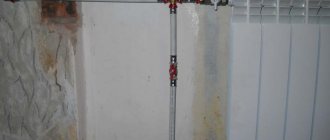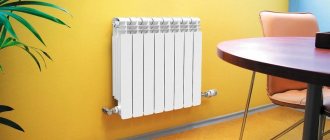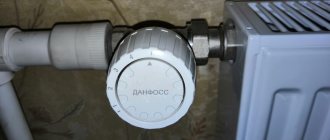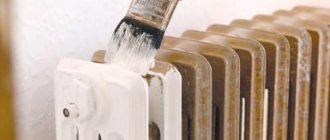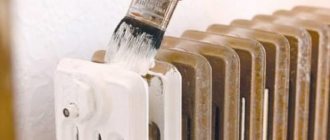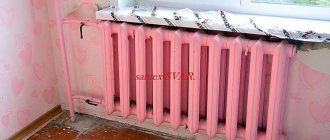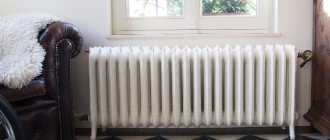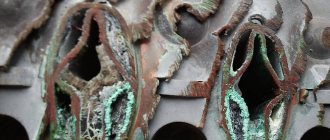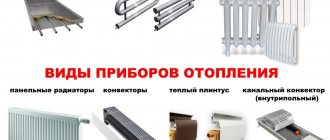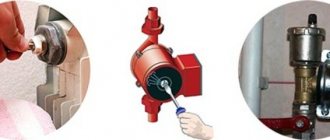It would seem that the utility workers are sparing neither effort nor fuel - they won’t touch the radiator. And at the same time, even in a warm robe, it’s uncomfortable in the house.
Olga Nesmelova · February 8, 2019
“Maybe the heating is bad?” - the hand itself reaches for the battery - check. We get burned, we pull back: no, they heat well, you can’t complain about it. But why then is it so cold?
You can find “pockets of frost” using thermal imaging. But it can be simpler. Exactly how, Vadim Vozny ,
When do you have to expand sections of heating radiators?
Of course, the reasons for low temperature conditions can be different and are associated not only with radiators, but also with the heating source and the pipe system. However, if this failure is caused by poor battery performance, then it can be simply fixed. Heating networks are designed in such a way that the temperature drop across the batteries should occur from 15 to 25 C at the lowest outside temperatures. If this range is not maintained and the devices are new and not clogged with sludge from network water, and the temperatures at the inlet and outlet of the batteries are almost equal, then in this case there is no heat removal from the battery. This indicates that the heating area of the batteries is insufficient and needs to be increased.
In addition, before expanding the heating battery, you will need to check their internal volume for cleanliness. This procedure must be carried out, especially if they have worked for several years without flushing, which should be carried out annually, before the heating season. In order to check that the heating devices are clean and not air-filled, it is necessary to open the valves on the radiators and drain a small amount of coolant. If air and dirty water come out of the tap, the heating system will need to be flushed.
Reason 2. Blockage in the battery
Corrosion, deposits deposited on the internal walls - because of them, the radiator can become clogged. If water is taken from a well as a coolant without preliminary purification, the radiator quickly becomes unusable, regardless of the quality of manufacture.
“If the batteries are clogged, it is better to replace them with modern models that are more resistant to corrosion. For example, on a bimetallic radiator, such batteries ensure 100% passability and uninterrupted operation even with the most polluted central heating systems,” advises the OBI expert.
Design features of bimetallic and aluminum devices
These modern heating devices appeared on the market after the owners of houses and apartments began en masse to make European-quality renovations. Both types of radiators have a similar principle of operation, and differ only in the construction materials from which they are made.
Aluminum has very high thermal conductivity, approximately 4 times greater than steel heating surfaces. Such characteristics make it possible to quickly warm up the walls of the heater housing. The hot walls of the heater transfer heat by two methods: radiation heating in the infrared range, which accounts for about 50–60% of the volume of transferred thermal energy, and convective heating of air flows, through direct heat transfer from the walls of the device to the washing air.
Under the influence of gravitational processes of natural circulation, hot air masses move upward along the interfin space of the convector, and new cold flows enter the radiator from below. Their movement has a vortex nature, which increases the heat transfer of the heating device.
Bimetallic devices are characterized by the greatest strength, withstanding environmental pressure up to 40 atm, which is much more than that of steel and cast iron batteries. The combination of two metals in one heating structure created unsurpassed thermal characteristics of the heater, higher than all radiators known today. Its internal surfaces are made of steel, and the ribbed surface, which releases thermal energy into the room, is made of aluminum spraying. That is why they have a long service life and are easy to maintain and install.
Large heat losses
Checking heat losses in the heating system is easily carried out using a special high-precision measuring device - a thermal imager. Such a device makes visible the infrared radiation emitted by surrounding objects and helps to measure temperature in a non-contact way with an accuracy of 0.1 ° C or better. The device display reflects the data of the measurements performed in the form of a color image, in which each shade corresponds to a strictly defined temperature range.
One of the time-tested and effective options for increasing the thermal output of the battery and reducing heat loss is to install a special reflector or screen made of aluminum foil behind the radiator. This very simple and cheap device will ensure that thermal energy is directed from the wall of the house directly into the room. As practice shows, the use of such a reflective screen can increase the thermal efficiency of the heating system by 12-15%. Among other things, it is strictly not recommended to cover the radiator with several layers of paint. In this case, heat loss often reaches the same 10-12% and with hot radiators you feel cold in the apartment.
The windows are “phoning”
Even the most modern and expensive plastic windows can cause heat loss as a result of improper glazing. Particular attention is required to improperly sealed joints that form between the window sill or wall and the window frame. All problem areas must be treated with silicone sealants or special polyurethane foam.
Problems with new windows are rather an exception to the rule. Most often, drafts occur when there are old windows with wooden frames in the room. And no matter how hot you make the radiators, it will still be cold in the apartment. In this case, the only way to get rid of heat loss through window openings once and for all is to install new multi-chamber plastic windows produced by well-established manufacturers.
Uninsulated walls, floors and ceilings
Residents of corner apartments and owners of residential premises with insufficiently insulated walls, floors and ceilings most often experience major problems with heating. As a rule, the simplest inspection reveals in such apartments the presence of cracks and gaps in the walls, ceilings and floors that easily let cold air masses in and heated air out of the room.
To seal cracks in walls, floors and ceilings, special primers and putty compounds are used. If necessary, reinforcement is performed. Good results are achieved by using special insulation materials. When choosing heat-insulating materials, you need to pay attention to the following parameters:
- thermal conductivity indicators;
- level of vapor permeability;
- ease of installation work;
- total volume of shrinkage;
- mass and density;
- hygroscopicity;
- durability;
- flammability;
- thickness.
The products that have proven themselves best are ROCKWOOL, HOTROCK SMART, TECHNIKOL XPS TECHNOPLEX, PENOPLEX COMFORT, KNAUF THERM HOUSE, ISOVER WARM HOUSE and URSA GEO.
Step-by-step work on connecting battery sections
Before expanding the battery, it will need to be dismantled and preparatory work carried out. Dust and corrosive deposits are removed from the radiator. Next, an inspection of the threaded connections necessary for connecting the device with in-house heating pipes is carried out. If growths are found during inspection, they will need to be removed. For this purpose, sandpaper is used, treating damaged surfaces with special care so that no foreign deposits remain, which in the future may cause leaks and fistulas.
Instructions for increasing the area of heating radiators
The owner of a residential premises who has decided to increase heating appliances must understand that they are being added exactly according to the standard sizes and brands of the heater that are already installed. Otherwise, these plans will fail due to a mismatch between the standard sizes and cross-sectional area of the inlet, geometric characteristics and the type of materials from which the radiators are made.
All work on batteries in a residential apartment building is carried out only with the permission of the operating organization. It is best in the summer, when central heating networks are not working, since during the work it will be necessary to completely drain the water from the intra-house network.
In a private house with one consumer input, such work can be carried out in the off-season, provided the outside air temperatures are positive and backup heating sources are available. Such a guarantee is needed in case the work on increasing temperatures takes a long time.
After shutting off the general water supply and draining it from the system, you will also need to drain the water from the battery itself. This happens by gravity when the futark is unscrewed. When the water is completely drained, nipples are applied to the connection, and intersectional sealing gaskets are placed on top. The nipple has a double-sided thread. A right-hand nipple is introduced on the condition that new sections will be added on the left side and vice versa.
Calculation of the number of sections
When the apartment owner has decided to take such an important step as expanding batteries, he will need to know the required number of sections. The power is indicated in the passport of the heating device; it can also be found out from reference books or on the Internet, knowing the modification of the battery.
Before determining the number of sections, you need to know the heating load that needs to be provided in a living room or house to maintain sanitary temperature indicators. There is a simple dependence, proven by practice: 10 m2 of area will require 1 kW of thermal power. This is an average indicator, it is more suitable for the central regions of Russia; for the northern and southern regions it will be necessary to introduce appropriate correction factors.
For example, for a room of 20 m2, the thermal power will be 2 kW.
The thermal power of 1 element of an aluminum radiator is 190 W, and a bimetallic one is 200 W.
To heat the room you will need sections:
- Aluminum - 2000: 190 = 10.5, rounded into 11 sections;
- bimetallic 2000: 200 = 10 sections.
Next, you will need to make adjustments to the type of wiring, the level of glazing and the level of thermal insulation of the building.
Where to go if the radiators are a little warm, but there is no trust in local housing and communal services representatives
After submitting a claim, you can wait a week, unless cold weather and life circumstances (for example, the presence of small children or weak health members in the family) force you to act earlier.
If there is no proper response, such a complaint should be sent to a higher authority - the district housing inspection or Rospotrebnadzor. To the document it is necessary to add information about the actions taken previously, a copy of the first statement, reporting the lack of an appropriate response from the FSW.
In case of repeated silence, the next authority will be the prosecutor's office. The submitted complaint must be accompanied by documentary evidence of the futility of previous attempts to resolve the issue and provide information about the harm caused by the inaction of officials to residents of the apartment.
You can also go to court, but cases are not considered quickly and it is better to go there after resolving the main part of the issue, presenting a claim for compensation for material and moral damage.
Citizens faced with such difficulties often express the opinion that it is useless to contact the local housing and communal services, advising them to act immediately through higher-level authorities or send the original complaint to the management company, and at the same time copies to all other regulatory organizations.
Each case is individual, and it is impossible to make unambiguous prejudicial judgments about all organizations of this kind. The scale and intensity of action taken depends on many factors. How persistently and where to complain about cold batteries, what to do in a particular case - everyone decides for themselves.
How to add sections to a bimetallic radiator
The removed and cleaned battery must be placed on a previously prepared straight plane. This is very important, since the bimetallic sections need to be combined without distortions, even very small ones. Unnoticeable at first glance, they can provoke a serious accident in the future.
Technique for increasing the area of a bimetallic battery
The extension of sections of this type is carried out in the following order:
- The freed device is placed on a flat surface, and the desired section is placed next to it. Take the nipple so as to achieve matching threads on the units being joined. Then it is turned onto the left section of the radiator, turning it only one thread.
- Next, perform similar steps for the lower threaded connection of the radiator.
- Next, the two parts chosen for connection are firmly pressed together. Sealing gaskets are placed between them, measuring the gap to the nipple. It is inserted at a proven size into a highly specialized opening at the reverse end of the battery. To be able to rotate the radiator key, a pipe key is used.
- When wrapping the nipple, you need to reach the point where it goes deep into the elements.
- At the end of the operation, the last 3 turns are performed with the radiator key. In this case, the nipple will be secured tightly.
- In a subsequent stage, the radiator key is moved to the opposite side of the battery. The winding technology is carried out in a similar manner. The fundamental condition is that in the end, the switching of sections must be extremely dense.
- Upon completion, the side plugs with paronite gaskets are installed. For such purposes, you will need a pipe wrench.
Which areas need to be insulated?
To reduce heat transfer from object to object, you need to put insulation on a warm object, as a result of which heat will leave it at a slower rate. Now the heat loss of the object will be directly affected by the thickness of the insulation and its heat resistance.
You can reduce the direct path of heat transfer if you place insulation in the following areas:
- house walls;
- floors;
- roof or ceiling;
- external and internal side surfaces of the foundation.
It is important! It is not practical to insulate the internal foundation if it is not insulated from the outside, because... this may cause it to freeze.
By the way, material on the topic:
Why does the roof freeze and how to deal with it?
Why do walls freeze and how to deal with it?
How to enlarge an aluminum radiator?
Such radiators are considered the warmest. It is thanks to the good thermal conductivity coefficient of aluminum that even a small device has high thermal power. Manufacturers of aluminum batteries have begun to use specialized anti-corrosion coatings, which allows for maximum use in a variety of heat supply systems.
Algorithm for increasing aluminum sections
It is quite easy to grow such batteries. The man in the house is capable of doing this kind of work on his own. In this matter, it is only important not to confuse the threads on the nipple.
Procedure for extending aluminum sections:
- The radiator is being dismantled.
- A nipple with a sealing gasket is inserted into both structures.
- Screw in the nipple alternately, a couple of turns at the top/bottom until they connect.
- Perform final tightening of the nipple, being careful not to damage the thread.
What to do?
Check if the battery is connected correctly. Then open the water inlet and outlet taps to full capacity. If you find any malfunctions, repair or replace the components.
Then release the air lock. If that doesn't help, clean the radiators.
After each heating season, check the operation of the shut-off valves. Install Mayevsky taps if they do not exist. If the heat is distributed unevenly, call a specialist.
Important: not all problems can be fixed on your own. If the top of the battery is hot for several days, this is a reason to troubleshoot. If you are not confident in your abilities, call an REP employee.
The best way to make the temperature in heating devices uniform is to replace old models with new ones. Modern bimetallic products have increased heat transfer rates and a reliable design that is not susceptible to corrosion.
